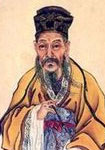春归百禽嚎
既移洛阳花,又种阮家竹。
五色杂黄红,一林常翠绿。
其间广亭开,亦欲危榭筑。
春归百禽嚎,抟黍及布谷。
桑上啄椹食,林下窥果熟。
果收椹已尽,飞去不须逐。
婆娑黄杨树,谁谓逢闰缩。
物犹有进退,此理何用告。
余心当效君,未有地可卜。
缀书岂贫乐,且以苟微禄。
春归百禽嚎。宋代。梅尧臣。城临太行谷,谷暖宜草木。既移洛阳花,又种阮家竹。五色杂黄红,一林常翠绿。其间广亭开,亦欲危榭筑。春归百禽嚎,抟黍及布谷。桑上啄椹食,林下窥果熟。果收椹已尽,飞去不须逐。婆娑黄杨树,谁谓逢闰缩。物犹有进退,此理何用告。余心当效君,未有地可卜。缀书岂贫乐,且以苟微禄。
《寄题刘仲叟泽州园亭》是宋代梅尧臣创作的一首诗词。这首诗词描绘了一个位于泽州的园亭景致,展示了自然环境和人文景观之间的和谐融合。
诗词的中文译文如下:
城临太行谷,
The city is located near the Taihang Valley,
谷暖宜草木。
The valley is warm and suitable for vegetation.
既移洛阳花,
Having transplanted flowers from Luoyang,
又种阮家竹。
And planted bamboo from the Ruan family.
五色杂黄红,
Various colors blend in yellow and red,
一林常翠绿。
A forest always dressed in green.
其间广亭开,
Amidst it, a spacious pavilion stands,
亦欲危榭筑。
As if to build a precarious pavilion.
春归百禽嚎,
Spring's return echoes with the cries of countless birds,
抟黍及布谷。
They peck at millet and peck at sorghum.
桑上啄椹食,
On the mulberry tree, they peck at the ripe fruit,
林下窥果熟。
Under the forest, they observe the ripening fruits.
果收椹已尽,
When the fruits are harvested and the mulberries are gone,
飞去不须逐。
The birds fly away without needing to be pursued.
婆娑黄杨树,
The yellow poplar trees sway gracefully,
谁谓逢闰缩。
Who says they shrink when encountering intercalary months?
物犹有进退,
All things have their advances and retreats,
此理何用告。
Why bother stating this principle?
余心当效君,
As for me, I should emulate you, my lord,
未有地可卜。
But I have yet to find a place to settle.
缀书岂贫乐,
Though I am not wealthy or contented by tying books together,
且以苟微禄。
I can still find temporary solace in a meager livelihood.
这首诗词通过描绘泽州园亭的景色,抒发了诗人的情感和思考。诗人描绘了城市临近太行山谷的美景,谷地温暖适合生长草木。他移植了洛阳的花卉,种植了阮家的竹子,形成了五色杂陈、常翠的林间景观。园亭宽敞开放,仿佛要建造一个高耸的亭榭。春天到来时,百禽嚎叫,觅食黍和谷子。鸟儿在桑树上啄食椹果,林下窥视着果实的成熟。当果实收获,椹果已尽,鸟儿飞走了,不需要追逐。黄杨树摇曳多姿,没有人会说它们因为逢闰月而缩小。诗人通过描绘自然界中事物的进退,表达了对这种无常现象的思考,并表示自己愿意效仿刘仲叟,但却未能找到合适的居所。他谦虚地说自己并不富有,也没有获得满足,只能以微薄的收入勉强维持生活。
这首诗词以优美的语言描绘了泽州园亭的景色,同时通过自然景观和诗人的内心感受,表达了对人生和命运的思考。它展示了自然与人文的和谐共生,以及人们对于繁华背后的寄题刘仲叟泽州园亭》是宋代梅尧臣创作的一首诗词。这首诗词描绘了一个位于泽州的园亭景致,展示了自然环境和人文景观之间的和谐融合。
诗词的中文译文如下:
城临太行谷,
The city overlooks the Taihang Valley,
谷暖宜草木。
The valley is warm and suitable for plants and trees.
既移洛阳花,
Transplanted flowers from Luoyang,
又种阮家竹。
And planted bamboo from the Ruan family.
五色杂黄红,
Colors blend in yellow and red,
一林常翠绿。
A forest that remains evergreen.
其间广亭开,
In between, a spacious pavilion stands,
亦欲危榭筑。
As if desiring to build a precarious pavilion.
春归百禽嚎,
Spring's return, a cacophony of countless birds,
抟黍及布谷。
Pecking at millet and pecking at sorghum.
桑上啄椹食,
On mulberry trees, pecking at ripe fruits,
林下窥果熟。
Under the forest, observing the ripening fruits.
果收椹已尽,
When fruits are harvested, mulberries are gone,
飞去不须逐。
Flying away without needing to be pursued.
婆娑黄杨树,
Graceful yellow poplar trees,
谁谓逢闰缩。
Who claims they shrink during intercalary months?
物犹有进退,
All things have their advances and retreats,
此理何用告。
Why bother stating this principle?
余心当效君,
I wish to emulate you, my lord,
未有地可卜。
But I have no place to settle.
缀书岂贫乐,
Stringing books together, how impoverished and joyless it seems,
且以苟微禄。
Yet I content myself with a meager livelihood.
这首诗词通过描绘泽州园亭的景色,抒发了诗人的情感和思考。诗人描绘了城市临近太行山谷的美景,谷地温暖适合生长草木。他移植了洛阳的花卉,种植了阮家的竹子,形成了五色杂陈、常翠的林间景观。园亭宽敞开放,仿佛要建造一个高耸的亭榭。春天到来时,百禽嚎叫,觅食黍和谷子。鸟儿在桑树上啄食椹果,林下窥视着果实的成熟。当果实收获,椹果已尽,鸟儿飞走了,不需要追逐。黄杨树摇曳多姿,没有人会说它们因为逢闰月而缩小。诗人通过描绘自然界中事物的进退,表达了对这种无常现象的思考,并表示自己愿意效仿刘仲叟,但却未能找到合适的居所。他谦虚地说自己并不富有,也没有获得满足,只能以微薄的收入勉强维持生活。
这首诗词以优美的语言描绘了泽州园亭的景色,同时通过自然景观和诗人的内心感受,表达了对人生和命运的思考。它展示了自然与人文的和谐共生,以及人们对于繁华背后的深思和对命运无常的领悟。整首
梅尧臣
梅尧臣(1002~1060)字圣俞,世称宛陵先生,北宋著名现实主义诗人。汉族,宣州宣城(今属安徽)人。宣城古称宛陵,世称宛陵先生。初试不第,以荫补河南主簿。50岁后,于皇祐三年(1051)始得宋仁宗召试,赐同进士出身,为太常博士。以欧阳修荐,为国子监直讲,累迁尚书都官员外郎,故世称“梅直讲”、“梅都官”。曾参与编撰《新唐书》,并为《孙子兵法》作注,所注为孙子十家著(或十一家著)之一。有《宛陵先生集》60卷,有《四部丛刊》影明刊本等。词存二首。...
梅尧臣。梅尧臣(1002~1060)字圣俞,世称宛陵先生,北宋著名现实主义诗人。汉族,宣州宣城(今属安徽)人。宣城古称宛陵,世称宛陵先生。初试不第,以荫补河南主簿。50岁后,于皇祐三年(1051)始得宋仁宗召试,赐同进士出身,为太常博士。以欧阳修荐,为国子监直讲,累迁尚书都官员外郎,故世称“梅直讲”、“梅都官”。曾参与编撰《新唐书》,并为《孙子兵法》作注,所注为孙子十家著(或十一家著)之一。有《宛陵先生集》60卷,有《四部丛刊》影明刊本等。词存二首。
